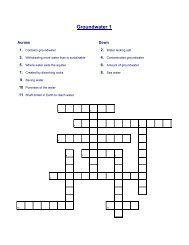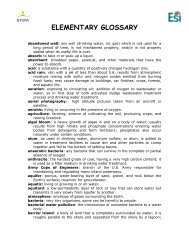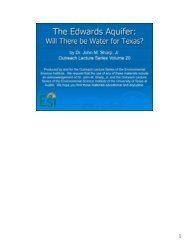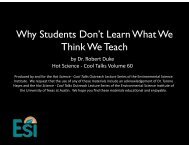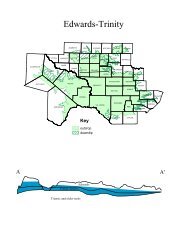Is Dilution the Solution to Pollution? - Environmental Science Institute
Is Dilution the Solution to Pollution? - Environmental Science Institute
Is Dilution the Solution to Pollution? - Environmental Science Institute
You also want an ePaper? Increase the reach of your titles
YUMPU automatically turns print PDFs into web optimized ePapers that Google loves.
Step 2: Introduce <strong>the</strong> <strong>to</strong>pic of pollution <strong>to</strong> <strong>the</strong> class and explore <strong>the</strong> different<br />
types of pollution in water. Show <strong>the</strong> class a clear glass of tap water and<br />
ask it is safe <strong>to</strong> drink. Ask why <strong>the</strong>y said yes or no.<br />
Step 3: Instruct students <strong>to</strong> immediately clean up any spilled water.<br />
Step 4: Describe <strong>the</strong> lesson steps:<br />
4a: Teacher will put 10 drops of dye in<strong>to</strong> cup #1 for each team.<br />
4b: Record <strong>the</strong> color of <strong>the</strong> liquid in cup #1 in <strong>the</strong> data table.<br />
4c: Using <strong>the</strong> eyedropper, students will take one drop from cup #1<br />
and place it in cup #2<br />
4d: Rinse eyedropper thoroughly in <strong>the</strong> rinse beaker.<br />
4e: Add 9 drops of water from <strong>the</strong> clean water beaker <strong>to</strong> cup #2.<br />
Carefully swirl <strong>the</strong> egg car<strong>to</strong>n <strong>to</strong> mix <strong>the</strong> contents.<br />
4f: Record <strong>the</strong> color of <strong>the</strong> liquid in cup #2.<br />
4g: Repeat steps 4c <strong>to</strong> 4f for each of <strong>the</strong> remaining cups. Each cup<br />
receives one drop from <strong>the</strong> preceding cup and 9 drops of clean<br />
water.<br />
Step 4: Have each team of students get tap water for each of <strong>the</strong>ir beakers;<br />
also ask <strong>the</strong>m <strong>to</strong> get one eyedropper per team and <strong>to</strong> number <strong>the</strong> cups of<br />
<strong>the</strong> egg car<strong>to</strong>n.<br />
Step 5: Students should complete <strong>the</strong> exercise and record all <strong>the</strong>ir data.<br />
Step 6: Direct students <strong>to</strong> clean up all materials.<br />
Step 7: Have students calculate <strong>the</strong> concentration for each cup by<br />
multiplying <strong>the</strong> original drop concentration (<strong>the</strong> concentration of <strong>the</strong> last<br />
cup from which you just <strong>to</strong>ok that drop) by <strong>the</strong> dilution fac<strong>to</strong>r.<br />
Step 8: Instruct students <strong>to</strong> complete <strong>the</strong> question sheet.<br />
Modification: none<br />
Student Product: Students will produce a data table and a completed question<br />
sheet on <strong>the</strong> exercise.<br />
Closure: Collect data tables and question sheets. Discuss several questions with<br />
<strong>the</strong> class:<br />
<strong>Is</strong> dilution <strong>the</strong> solution for pollution<br />
At what dilution level would you feel safe drinking water with gasoline<br />
How would you determine <strong>the</strong> dilution level that would be considered safe<br />
Are <strong>the</strong> safe levels <strong>the</strong> same for all people (i.e., children vs. adults)<br />
How can you safely dispose of water contaminated with gasoline<br />
Assessment or evaluation: Complete <strong>the</strong> attached grading rubric <strong>to</strong> evaluate<br />
students on correct lab practices, properly completed data table, and correctness of<br />
questions.<br />
Extension:<br />
1. Construct graphs (scatter plots with points connected) of <strong>the</strong><br />
concentration of <strong>the</strong> dye in each of <strong>the</strong> cups. Have students describe <strong>the</strong> shape of<br />
<strong>the</strong> data line and whe<strong>the</strong>r it ever hits zero. Discuss how <strong>the</strong>se lower amounts are<br />
detected.



